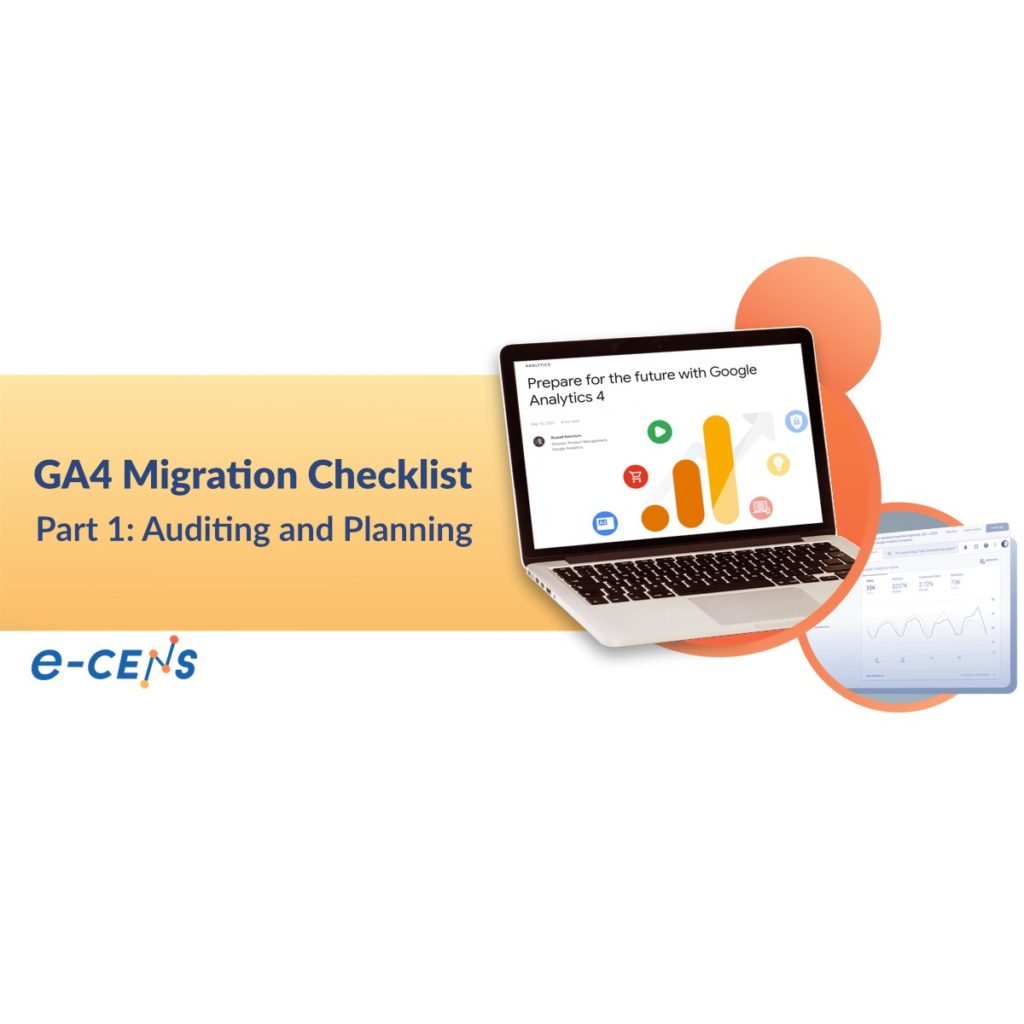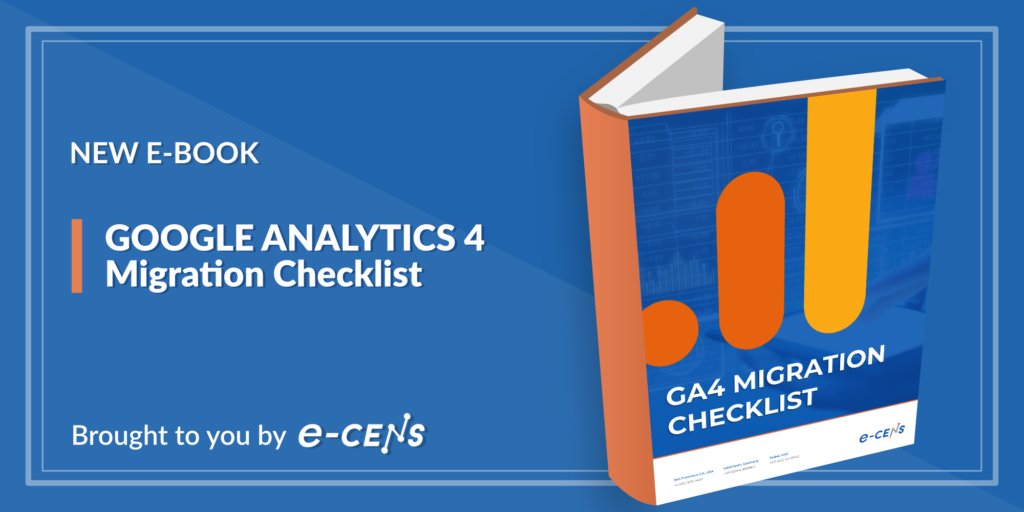In March, Google confirmed what experts in the web analytics space have been anticipating for some time now: Universal Analytics will be fully decommissioned by October 2023. After several years in beta, its successor, Google Analytics 4, will become the new default Google Analytics property.
While it may feel like a race against time to implement GA4 before UA’s sunset, it’s important to remember that being the first to adopt the new platform will mean nothing if you sacrifice the quality of your implementation.
e-CENS’ GA4 migration guide is here to help you plan your migration strategy and avoid rookie mistakes. In our series of articles detailing the recommended steps required for a successful migration to GA4, we’ll present an overview of how to achieve a successful GA4 implementation.
In the first item in this series, we’ll take a look at the foundations of an efficient Google Analytics 4 migration: auditing and planning.
Table of Contents
Audit
Many consultants will advise you to begin your GA4 migration by creating your new GA4 account. However, that is not the best place to start.
Auditing your current setup should be the first step of any quality migration process. That is especially true for this particular migration, as UA and GA4 collect and represent data in different ways. The sets of dimensions and metrics leveraged by Universal Analytics users for more than a decade are now significantly different in GA4.
For your business to undertake a smooth, lossless transition between the two analytics platforms, e-CENS recommends that you perform a detailed audit of your current analytics configuration. This includes going over priority events and event parameters, and detailing the metrics currently being collected. Afterward, these properties can be mapped into GA4 terms as faithfully as possible.
Building an event portfolio from scratch in GA4 without first detailing what is being tracked in the current analytics setup, introduces a significant margin for error and can lead to unnecessary gaps in data streams and the reports they inform, that might only be fixed much later.
What will an audit entail?
During the audit process, analysts will commonly examine the following:
1. Naming conventions
Never underestimate the importance of thoughtfully planned-out naming conventions. Going from basics such as Account Structure to Campaigns and Events, properly-labeled naming conventions will keep your data streams tightly organized and easily accessible. During the audit, the migration manager will examine how your naming conventions are set up in UA, identify any potential improvements that may be made, and formulate a strategy to transfer your setup to GA4. Some of the most common migration pitfalls happen right here – more on that below.
2. Types of user interactions tracked
User interactions refer to actions a visitor or customer makes with elements of your website or app. In Universal Analytics, such interactions are called ‘hits’ and are categorized into 8 different sub-types, including pageview, screenview, event, and transaction. In GA4, however, every interaction is considered an event, allowing for up to 25 additional granular parameters to classify the interaction. What this means for you, is that hits tracked in UA will most probably need to be ‘translated’ into custom parameters or dimensions in GA4.
3. Business KPIs
While tracking user interactions builds up a vital picture of your customer’s actions and engagements, what is critical in terms of measuring success is tracking your business’s unique set of KPIs. Depending on the industry and the company’s size and growth stage, KPIs vary. And, without a clear understanding of which KPIs are crucial to the current business plan, setting up key metrics to track in GA4 is impossible. For a deeper dive into defining KPIs, see our previous article.
4. Reports
Reports are at the center of Google Analytics. They are the primary sources of information for everyone within the company, whether they are part of marketing, sales, or the product development team. But, different teams rely on different reports, and with GA4’s narrow list of pre-built reports, certain teams could lose out on essential information. Detailing the reports you currently use in UA is essential to later build a quality report system in GA4.
5. Dashboards
The Dashboard is the control panel for your Google Analytics platform. This is most likely the first and last place most users visit, with easily-accessible visualizations of the company’s performance. To create a sense of a seamless transition for users and understand what a company’s vital goals are pre-migration, analysts will need to consult your Dashboard, paying attention to any existing customizations.
6. Business analysis
Finally, the migration advisor will consult with the head of the data analyst team or a C-suite representative to understand how the company uses its data to grow.

What will the audit provide?
After the audit, it will now be possible for data analysts to develop a well-rounded migration strategy with the following goal – implementing Google Analytics 4 in a way that is in line with the expectations of the business, and with minimum effort to stakeholders to adapt to the new tool.
Auditing positions enables your migration consultant to understand your business’s existing data analysis architecture, and provide them with a data stream map that can be later traced onto the GA4 data model.
Create your measurement plan
After assessing all of the above, existing user interactions and key KPIs in UA should be organized into a measurement plan.
Your measurement plan is a document that lists your company’s primary business goals and aligns those objectives with metrics and dimensions that are measured through GA4.
Put more simply, if one of your goals is to increase subscriptions to your service, the measurement plan will make a note of that; then, the document will map out what data is essential to track for you to monitor your progress to achieve that objective.
Filling out your measuring plan should start with answering a few key questions: What should be my event naming convention? How should I categorize user interactions? How should I detail them to gain even more insight?
While it will vary depending on the company, some metrics remain must-haves for everyone. These include generic user-initiated interactions (page visits, clicks, exit rates, etc.) and identifying user properties. Without a firm structurization of data at this base level, the dependent processes of reporting and analysis are severely limited.
Avoid these Rookie mistakes
Rushing the setup of naming conventions and event parameters is a common mistake to make during the early weeks of GA4 migration. Wanting to push through this lengthy task and complete it as soon as possible, some teams even create new events for every single user interaction. This is definitely not a recommended approach.
Proper event categorization is essential for data organization, ease of access, and user flow identification, i.e., the very essence of what will later help you paint an accurate picture of your user journey.
When setting up naming conventions, you should focus on being precise but also descriptive enough to be able to later analyze your data both vertically and horizontally.
Document your technical infrastructure
Technical infrastructure refers to any kind of tools and technologies you are working with. Is your website custom-built (native language), in hybrid format, or based on a development platform? What content management system do you use? Does your website have AMP pages (and in today’s mobile-first economy, it probably does), or is it a Single Page Application (SPA)? This needs to be recorded.
This information helps iron out the GA4 implementation plan – because naming conventions sometimes need to be adapted to the specific tools and tech that are in use. Depending on the setup, there might be some additional configuration necessary during the migration process. For example, the type of information that is readily accessible depends on the platform you’re using. For AMP pages, a straightforward implementation of new naming conventions and event parameters will simply not do the trick – additional work will be necessary to implement a fully functional GA4 configuration.
In view of this, your implementation plan should be built in accordance with your technical infrastructure.
Okay, what’s next?
After auditing your current Universal Analytics configurations and building a fool-proof GA4 implementation plan, congratulations! You are ready to start your migration process.
However, what follows is a series of more complex and time-consuming tasks. If you want to make sure you have a firm handle on everything this lengthy and demanding process takes, reach out to our expert consultants at e-CENS.
Stay tuned: In the next article in this series, we look at some essential GA4 migration strategy dos and don’ts.
Get the full picture: Check out the GA4 migration overview by e-CENS’ own Holger Tempel.
Learn more about GA4 migration with our new eBook
Optimize your workflow. In our GA4 Migration Checklist, we’ll take you through the essentials of a quality Google Analytics 4 (GA4) implementation.
Further reading
- GA4 Migration Checklist
- Google Analytics Implementation Checklist Strategy Dos and Dont’s
- From Urchin to GA4: A History of Google Analytics
- UA vs. GA4: What GA4’s Engagement Rate is Telling You
- UA vs. GA4: Campaign Tracking
- UA vs. GA4: Report Landscape
- The Anatomy of a Hit: Behind GA4’s Event-Based Data Model





